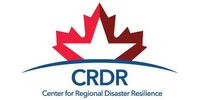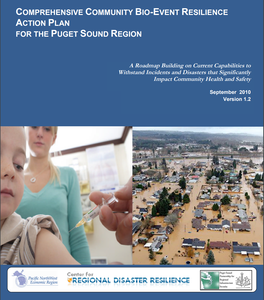|
PNWER has been awarded an EDA Grant to develop a Comprehensive Regional Pandemic Resilience Roadmap following the COVID-19 pandemic. This will be an opportunity to build upon PNWER's previous work in 2010 on a Comprehensive Community Bio-Event Resilience Action Plan following the H1N1 pandemic. The primary focus of this project is to produce a Roadmap to improve capacities of communities to safely and successfully address the challenges and economically recover from a pandemic. The project will identify gaps, examine what can be improved, and define an implementation plan for best practices and methods identified nationwide with a cross-sector and multi-discipline approach. Shortening the period of maximum economic constraint will do much to limit the economic damages done to individuals, families, and small businesses. This effort will also provide valuable lessons learned that can be used immediately and shared with other metropolitan areas across the United States facing similar challenges. The Roadmap will include a playbook for use by other regions of the nation. The Comprehensive Pandemic Resilience Roadmap will incorporate lessons learned from COVID-19 pandemic and pandemic resilience best practices with a strong focus on economic challenges in the context of health safety, the implications for preparedness, response, recovery, and mitigation, and identify needs and respective improvement actions. The Roadmap will help with the present pandemic and prepare the Central Puget Sound for future pandemics while at the same time assisting in lessening future blows to the economic welfare of the region, by enhancing capacity of local governments, economic development agencies, and business associations to be better prepared for safe operation, and economic survival. The COVID-19 pandemic has highlighted a host of additional complex issues and shortfalls, including unexpected, deleterious, and far-reaching repercussions for local and regional economies that demonstrate limited understanding of and capabilities to address competing interests and needs in the context of inter-related economic and health resilience demands. These challenges cut across the resilience mission areas of protection, preparedness, mitigation, response, and recovery, and include an extensive range of new needs. Looking just at economic recovery, issues include healthcare and business supply chains; human resource considerations, such as protecting staff, sick leave, emergency leave, flexible child-care arrangements, dealing with ill workers, telecommuting, insurance coverage, etc.; better informed and coordinated decision-making across communities to address risks associated with business closure and restarts, quarantines, and social distancing versus health impacts; and how to keep businesses and other entities in operation and attract new investments and economic development opportunities. An overarching challenge is how to address the impact of social media on public behavior, fears, and attitudes that have a direct bearing on economic recovery. Beyond this, communities and regions need to not only recover, but they need to have the resources, tools, and other capabilities to build and sustain pandemic resilience to thrive and grow.
0 Comments
The Action Plan identifies needs and recommends more than six dozen activities to meet these needs in 12 focus areas. It provides a template in matrix format that stakeholders can use to prioritize these recommendations and determine lead and partner organizations for each activity. This matrix offers a tool for stakeholders to use to take the next step to create work groups to identify project requirements and sources of potential funds and expertise for implementation. Lastly, the Action Plan includes guidance on how stakeholders can create a sustainable, continuous improvement process through incorporating into the Plan new bio-resilience needs and activities based on lessons learned from events and exercises. This continuous improvement process will provide a means to measure progress as Action Plan activities are completed.
This document describes a holistic, systematic approach for determining needed actions to improve regional capabilities to withstand bio-events that significantly impact community health and safety, and to rapidly recover to normal or new normal conditions. The geographic focus of the Comprehensive Community Bio-Event Resilience Action Plan is the Puget Sound Region of Washington State, which includes the Greater Seattle Area, the Pacific Northwest’s largest metropolitan area. The Action Plan is the culmination of a federally-sponsored pilot project led by the Center for Regional Disaster Resilience of the Pacific NorthWest Economic Region (PNWER), a bi-national statutory non-profit organization comprised of Washington, Oregon, Alaska, Idaho, Montana, British Columbia, Alberta, Saskatchewan, Yukon, and the Northwest Territories. The Action Plan provides a template that can be readily customized for use by states and localities with key stakeholders to gauge the current level of preparedness to deal with anticipated and unexpected incidents and disasters. This Action Plan was developed by a broad stakeholder group of public health, emergency management, and other government officials, and utility, business, and non-profit representatives. The approach used was a multi-step process developed by the PNWER Center for Regional Disaster Resilience that has been employed in other parts of the nation and Canada to bring cross-sector and multi-jurisdiction representatives together with experts from diverse disciplines to examine vulnerabilities, consequences, and preparedness gaps for all-hazards incidents and disasters. This facilitated process enables stakeholders to work with government partners to develop and conduct a series of educational workshops, a tabletop exercise and a baseline needs assessment to collectively determine areas of improvement and cost-effective solution options. While the Action Plan is focused on bio-events, the same template can be adapted for any hazard to identify, prioritize, and develop requirements for activities that can provide a dynamic, flexible, and ongoing path forward to enhance community resilience. The effects of a global influenza pandemic on critical infrastructures and essential service providers was the focus of the fourth Blue Cascades regional interdependencies tabletop exercise, held January 25, 2007 in Seattle, WA. Participants included more than 250 representatives from public, private sector, non-profit, academic, community, and other organizations. The overall goal of the exercise was to raise awareness of impacts on critical infrastructures and essential services from a pandemic and of stakeholder preparedness plans and resources; illuminate issues related to roles and missions; and gauge the effectiveness of regional communications and coordination. A major objective of Blue Cascades IV was to enable participants to identify shortfalls and potential solutions that could be incorporated into a regional pandemic preparedness Action Plan.
The scenario, procedures, and supporting materials for Blue Cascades IV were developed by a Scenario Design Team of more than 50 key stakeholders, with facilitation provided by the Pacific NorthWest Economic Region, a state-chartered consortium of five states (Washington, Oregon, Alaska, Idaho, and Montana) and three Canadian jurisdictions (British Columbia, Alberta, and The Yukon Territory). The scenario focused on Puget Sound, Washington State and cross-national border activities in response to a hypothetical avian influenza H5N1 outbreak that spreads to the United States from Asia. During the day-long exercise, participants were provided “mini-briefings” from public health officials and experts on local, state, federal and private sector pandemic plans and policies. Among topics explored were public health impacts, implementation of disease control measures such as quarantines, isolation, travel restrictions, school closures, and bans on public gatherings; personnel shortages and related human factors; and impacts on transportation, water and waster water systems, supply chains (e.g., food and pharmaceutical supplies), hospitals, financial institutions, electric power, natural gas, and fuel. Also addressed were the roles of the National Guard, law enforcement, private security personnel, the Coast Guard, and regional military assets. A particular focus of the scenario was telecommuting and communications challenges and associated cyber security concerns related to employees working from their homes during a pandemic. The exercise scenario in addition looked at the ability of responders to deal with other disasters during a pandemic (in this case, a severe storm) and focused on restoration activities through a second wave of the influenza pandemic. The Blue Cascades Interdependencies Exercise Series began in 2002 as way for regional stakeholders to proactively identify and strengthen gaps in their infrastructures. The Blue Cascades tabletop exercises are scenario-based discussion events developed by and for key stakeholder organizations that have roles and responsibilities or significant interests in assuring the security and resilience of the Puget Sound Region and the critical infrastructures and essential service organizations that underpin citizens’ health, safety, and economic well-being.
Developed and facilitated by the stakeholders themselves, the Blue Cascades exercises focus on all-hazards. The chief goal of these tabletop exercises is not to test plans and procedures but rather to raise awareness of infrastructure interdependencies and associated vulnerabilities, impacts, and preparedness gaps, identifying potential solutions to make needed improvements. The After Action Reports of the Blue Cascades Exercises are used to develop Action Plans of stakeholder recommended and prioritized activities. These activities may be short-term (one year or less), medium term (eighteen months to two years), or long-term (multi-year). All require cross-sector, multi-jurisdiction, and in most cases, multi-discipline collaboration and expertise to implement. Participants in the Blue Cascades exercises represent all levels of government, utilities, businesses, and other private sector organizations, non-profits, academic, and community institutions. Blue Cascades Interdependencies Exercise Series:
|
Categories
All
Archives
October 2021
|


